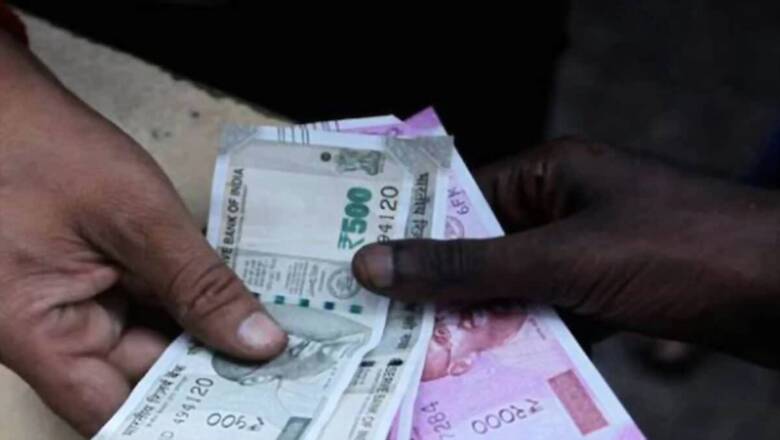
views
In a significant move, the Reserve Bank of India (RBI) on Friday announced the withdrawal of Rs 2,000 currency notes from circulation, while ensuring that the existing notes will remain legal tender. According to the RBI statement, individuals can deposit or exchange their Rs 2,000 bank notes by September 30.
To avoid disruption, the RBI has advised banks to cease issuing Rs 2,000 denomination banknotes immediately. From May 23, individuals can exchange Rs 2,000 notes for other denominations up to a limit of Rs 20,000 at a time at the 19 Regional Offices (ROs) of the RBI that have issue departments.
According to the RBI, a four-month period is deemed sufficient for individuals to exchange their notes with banks, sources told ANI. The majority of Rs 2000 notes currently in circulation are expected to be returned to banks within the designated timeframe. This is a routine procedure undertaken by the RBI, and there is no need for the public to be alarmed, as per sources.
RBI to Withdraw Rs 2,000 Notes: Key Highlights
- Rs 2,000 bank notes to be phased out from circulation
- Existing Rs 2,000 notes continue to be legal tender
- Banks instructed to halt issuance of Rs 2,000 notes immediately
- Depositing/exchanging Rs 2,000 notes at banks permitted until September 30, 2023
- Exchange facility limited to Rs 20,000 at a time for Rs 2,000 notes
This move by the RBI marks a significant development in the Indian currency landscape and will impact individuals, businesses, and financial institutions alike.
Why are the Rs 2,000 Currency Notes Being Withdrawn?
The decision to withdraw the Rs 2,000 bank notes comes after its introduction in 2016 under Section 24(1) of the RBI Act, 1934 to meet the immediate currency requirements following the demonetization of Rs 500 and Rs 1,000 notes.
However, with the objective accomplished and sufficient availability of other denominations, the printing of Rs 2,000 notes ceased in 2018-19, according to a Moneycontrol article.
According to the RBI, approximately 89% of the Rs 2,000 denomination banknotes were issued before March 2017 and have reached their estimated lifespan of 4-5 years. The total value of these banknotes in circulation has decreased from its peak of Rs 6.73 lakh crore on March 31, 2018 (accounting for 37.3% of the notes in circulation) to Rs 3.62 lakh crore, representing only 10.8% of the notes in circulation as of March 31, 2023.
Additionally, this particular denomination is not commonly used for daily transactions. The RBI has observed that an ample stock of banknotes in other denominations exists to meet the currency demand of the public.
Considering these factors and in alignment with the RBI’s “Clean Note Policy,” the decision has been taken to withdraw the Rs 2,000 banknotes from circulation. The Clean Note Policy is a measure implemented by the Reserve Bank of India (RBI) to ensure the circulation of high-quality banknotes for the convenience and satisfaction of the public.
In January 2014, the RBI announced the withdrawal of all banknotes issued prior to 2005.
What is the legal tender status of Rs 2,000 notes?
While the withdrawal aims to streamline operations, it ensures that the Rs 2,000 denomination remains valid for transactions. The legal tender status of Rs 2,000 banknotes remains unchanged.
Can Rs 2000 Notes be Used for Regular Transactions? What is the Deadline?
Yes, Rs 2,000 banknotes can still be used for regular transactions. People are advised to use them as usual and can also accept them as a form of payment. However, it is recommended to deposit or exchange these banknotes by September 30, 2023.
How to Deposit or Exchange Rs 2000 Notes?
Individuals are advised to visit their respective bank branches to deposit or exchange the Rs 2,000 denomination banknotes they possess. This facility will be accessible at all banks until September 30, 2023. Additionally, the option to exchange these banknotes will also be available at the 19 Regional Offices (ROs) of the Reserve Bank of India (RBI) that have Issue Departments until the same deadline.
What is the limit on depositing Rs 2,000 notes into bank accounts?
Deposits into bank accounts can be made without restrictions, subject to compliance with applicable KYC norms and regulatory requirements.
What is the limit on Rs 2,000 notes that can be exchanged?
People can exchange Rs 2,000 banknotes up to a limit of Rs 20,000 at a time.
How to deposit more than Rs 20,000 cash for business or other purposes?
Deposits can be made without restrictions, and cash can be withdrawn against these deposits to fulfill higher cash requirements.
Can Rs 2,000 notes be exchanged through Business Correspondents (BCs)?
Yes, Rs 2,000 banknotes can be exchanged through BCs, with a limit of Rs 4,000 per day for account holders.
When will the cash exchange facility be available?
The exchange facility will be available from May 23, 2023, at bank branches and RBI Regional Offices (ROs).
Is it necessary to be a bank customer to exchange Rs 2,000 banknotes?
No, even non-account holders can exchange Rs 2,000 banknotes up to a limit of Rs 20,000 at any bank branch.
Will there be Service Charges for the Exchange of Rs 2000 Notes?
No, the exchange facility is provided free of cost.
Special arrangements for senior citizens and persons with disabilities?
Banks have been instructed to make special arrangements to minimise inconvenience for senior citizens and persons with disabilities during the exchange and deposit process.
Can’t immediately exchange or deposit Rs 2000 Notes? No Worries
If individuals are unable to deposit or exchange their Rs 2,000 banknotes immediately, they need not worry. The RBI has allowed a generous period of over four months for the deposit and/or exchange process. It is advised that members of the public take advantage of this facility at their convenience within the specified timeframe.
RBI’s grievance resolution process for Rs 2000 notes, Full Details
In the rare event that a bank refuses to exchange, accept, or deposit Rs 2,000 banknotes, individuals can seek redress by following the grievance resolution process. They should initially approach the concerned bank and lodge a complaint.
If the bank does not respond within 30 days or if the resolution provided is unsatisfactory, individuals can escalate the matter by filing a complaint under the Reserve Bank – Integrated Ombudsman Scheme (RB-IOS), 2021. Complaints can be lodged through RBI’s Complaint Management System portal (cms.rbi.org.in).



















Comments
0 comment